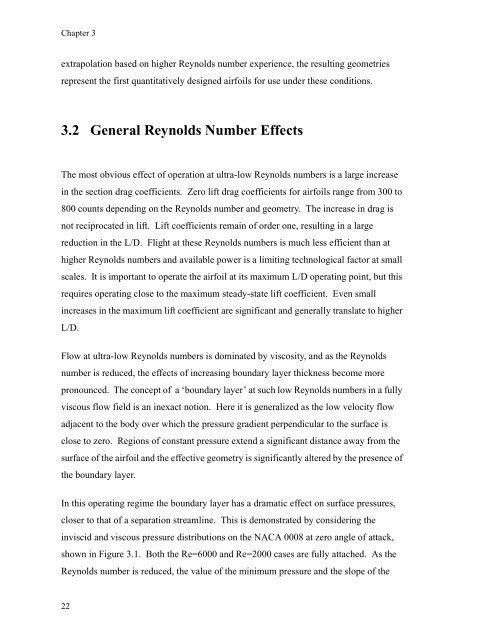Aerodynamics and Design for Ultra-Low Reynolds Number Flight
Aerodynamics and Design for Ultra-Low Reynolds Number Flight
Aerodynamics and Design for Ultra-Low Reynolds Number Flight
You also want an ePaper? Increase the reach of your titles
YUMPU automatically turns print PDFs into web optimized ePapers that Google loves.
Chapter 3<br />
extrapolation based on higher <strong>Reynolds</strong> number experience, the resulting geometries<br />
represent the first quantitatively designed airfoils <strong>for</strong> use under these conditions.<br />
3.2 General <strong>Reynolds</strong> <strong>Number</strong> Effects<br />
The most obvious effect of operation at ultra-low <strong>Reynolds</strong> numbers is a large increase<br />
in the section drag coefficients. Zero lift drag coefficients <strong>for</strong> airfoils range from 300 to<br />
800 counts depending on the <strong>Reynolds</strong> number <strong>and</strong> geometry. The increase in drag is<br />
not reciprocated in lift. Lift coefficients remain of order one, resulting in a large<br />
reduction in the L/D. <strong>Flight</strong> at these <strong>Reynolds</strong> numbers is much less efficient than at<br />
higher <strong>Reynolds</strong> numbers <strong>and</strong> available power is a limiting technological factor at small<br />
scales. It is important to operate the airfoil at its maximum L/D operating point, but this<br />
requires operating close to the maximum steady-state lift coefficient. Even small<br />
increases in the maximum lift coefficient are significant <strong>and</strong> generally translate to higher<br />
L/D.<br />
Flow at ultra-low <strong>Reynolds</strong> numbers is dominated by viscosity, <strong>and</strong> as the <strong>Reynolds</strong><br />
number is reduced, the effects of increasing boundary layer thickness become more<br />
pronounced. The concept of a ‘boundary layer’ at such low <strong>Reynolds</strong> numbers in a fully<br />
viscous flow field is an inexact notion. Here it is generalized as the low velocity flow<br />
adjacent to the body over which the pressure gradient perpendicular to the surface is<br />
close to zero. Regions of constant pressure extend a significant distance away from the<br />
surface of the airfoil <strong>and</strong> the effective geometry is significantly altered by the presence of<br />
the boundary layer.<br />
In this operating regime the boundary layer has a dramatic effect on surface pressures,<br />
closer to that of a separation streamline. This is demonstrated by considering the<br />
inviscid <strong>and</strong> viscous pressure distributions on the NACA 0008 at zero angle of attack,<br />
shown in Figure 3.1. Both the Re=6000 <strong>and</strong> Re=2000 cases are fully attached. As the<br />
<strong>Reynolds</strong> number is reduced, the value of the minimum pressure <strong>and</strong> the slope of the<br />
22




